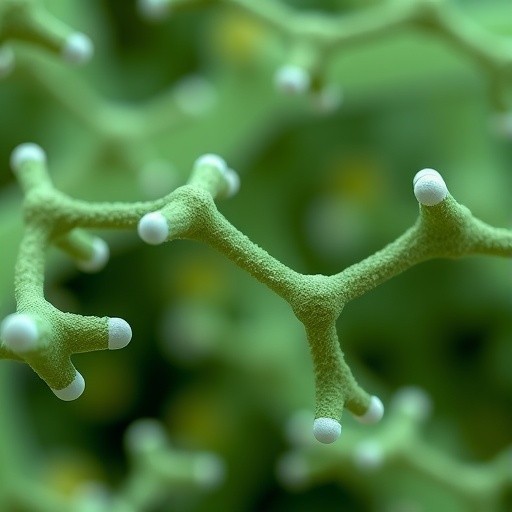In recent years, the rise of multidrug-resistant bacteria has posed a significant challenge to global health systems. One study that shines a light on the ongoing battle against these pathogens is conducted by Eladl, which focuses on the biophysical and transcriptomic characterization of LL-37-derived antimicrobial peptides. This research is particularly relevant in the context of ESKAPE pathogens and multidrug-resistant strains of Escherichia coli, notorious for their ability to evade conventional treatments.
The antimicrobial peptide LL-37, derived from human cathelicidin, represents a fascinating candidate for combating these formidable foes. Known for its broad-spectrum activity against various microbes, LL-37 also possesses anti-inflammatory properties that may be advantageous in therapeutic applications. However, the precise mechanisms through which LL-37 operates against such resistant strains have yet to be fully elucidated, making this study particularly crucial.
In their work, Eladl and collaborators employed detailed biophysical characterization techniques to analyze the behavior of LL-37 peptides in the presence of agar and artificial membranes. Through these experiments, they aimed to determine how the antimicrobial peptide interacts with and disrupts bacterial membranes, a key factor in its effectiveness against drug-resistant strains. Such insights can pave the way for designing more effective antimicrobials or improving existing therapies.
Moreover, the researchers conducted transcriptomic analyses to study the genetic responses of multidrug-resistant E. coli when exposed to LL-37. This part of the study unveiled the significant shifts in gene expression that occur when these bacteria encounter the antimicrobial peptide. Understanding the molecular pathways activated in response to LL-37 is vital for developing strategies to enhance its efficacy and mitigate any potential resistance development.
The challenge posed by ESKAPE pathogens, characterized by their ability to evade the immune response and resist multiple antibiotics, necessitates innovative research approaches. Pathogens such as Staphylococcus aureus, Enterococcus faecium, Klebsiella pneumoniae, Acinetobacter baumannii, Pseudomonas aeruginosa, and Enterobacter species form a formidable group in hospital settings, often leading to serious infections that are difficult to treat. LL-37’s activity against such pathogens raises hopes for new treatment avenues, especially given its unique mechanism of action.
One of the primary appeals of LL-37 is its capacity to induce permeabilization of bacterial membranes without relying solely on classical antibiotic mechanisms. Traditional antibiotics typically target specific bacterial processes such as cell wall synthesis or protein production, which can lead to the development of resistance. In contrast, LL-37 appears to disrupt the integrity of the cell membrane, making it a promising candidate to potentially sidestep the resistance pathways that bacteria have developed.
The implications of this research extend beyond understanding LL-37’s direct antimicrobial effects. The modulation of the host immune response by LL-37 presents an additional avenue for exploration. The peptide has been shown to exhibit immunomodulatory effects, potentially enhancing the body’s ability to combat infections while also reducing inflammation. These dual effects could be immensely beneficial in treating infections caused by multidrug-resistant organisms.
Furthermore, understanding how LL-37 affects gene expression in resistant E. coli may help identify new targets for antibiotic development. As the study reveals shifts in expression patterns, it could guide researchers towards alternative pathways that can be exploited either by developing new drugs or repurposing existing ones to work in conjunction with LL-37.
Future research inspired by Eladl’s findings could also explore how the stability of LL-37 in various biological environments affects its antimicrobial efficacy. Investigating how factors like pH, temperature, and the presence of serum proteins influence the peptide’s activity would provide crucial insights necessary for its clinical application. Ensuring the peptide remains active in the complex human body while effectively reaching its target is a key challenge in turning such promising laboratory results into real-world therapies.
In conclusion, Eladl’s pioneering work on LL-37-derived antimicrobial peptides unveils significant potential for addressing the growing threat of multidrug-resistant pathogens. By elucidating the biophysical interactions and transcriptomic responses of these novel therapeutic candidates, this study paves the way for exciting advancements in antimicrobial research. The battle against drug-resistant bacteria is ongoing, and studies like this bring renewed hope in the quest for innovative solutions.
As the scientific community continues to confront the rising problem of antimicrobial resistance, ongoing research will be essential to unlock the full potential of novel antimicrobial compounds like LL-37. By combining rigorous characterization with an understanding of the underlying biological mechanisms, future developments could revolutionize our approach to treating some of the most challenging infections known today.
Subject of Research: Antimicrobial peptide LL-37 against drug-resistant Escherichia coli and ESKAPE pathogens
Article Title: Biophysical and transcriptomic characterization of LL-37-derived antimicrobial peptide targeting multidrug-resistant Escherichia coli and ESKAPE pathogens.
Article References:
Eladl, O. Biophysical and transcriptomic characterization of LL-37-derived antimicrobial peptide targeting multidrug-resistant Escherichia coli and ESKAPE pathogens.
Sci Rep 15, 36126 (2025). https://doi.org/10.1038/s41598-025-22890-7
Image Credits: AI Generated
DOI: 10.1038/s41598-025-22890-7
Keywords: Antimicrobial peptides, LL-37, multidrug resistance, E. coli, ESKAPE pathogens, biophysical characterization, transcriptomic analysis.
Tags: anti-inflammatory properties of peptidesantimicrobial peptidesbacterial membrane disruptionbiophysical characterization techniquescombating drug-resistant infectionsEscherichia coli resistanceESKAPE pathogensLL-37 antimicrobial peptidemultidrug-resistant bacterianovel antimicrobial strategiestherapeutic applications of LL-37transcriptomic analysis of pathogens





